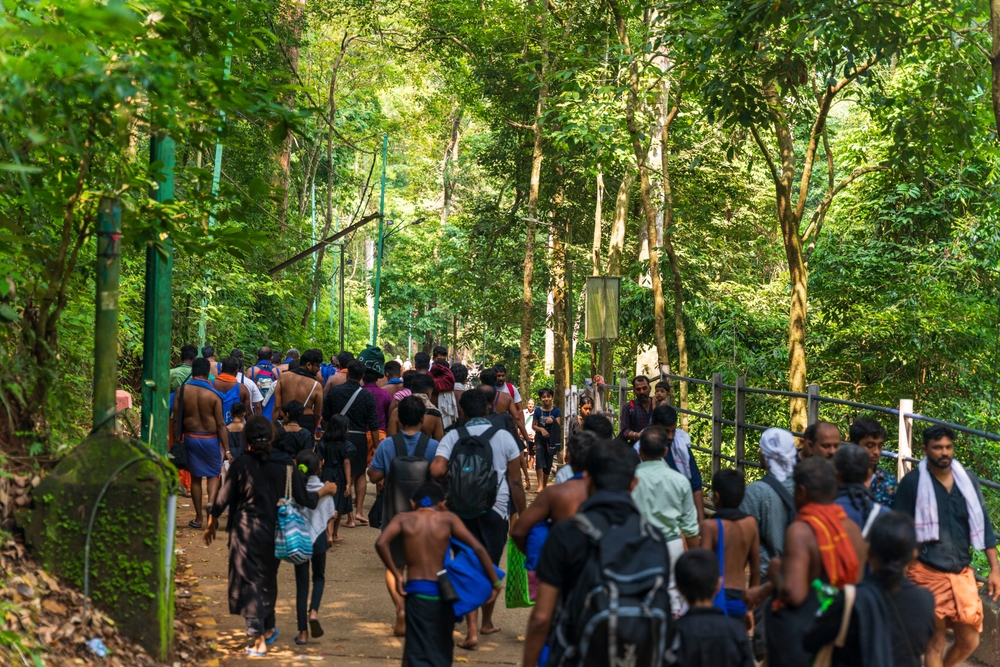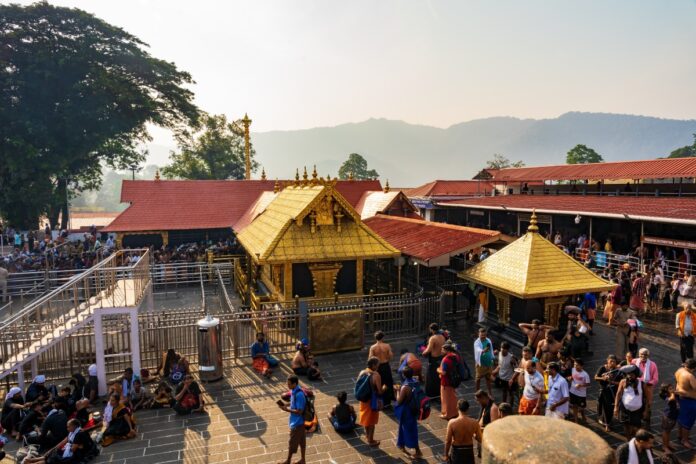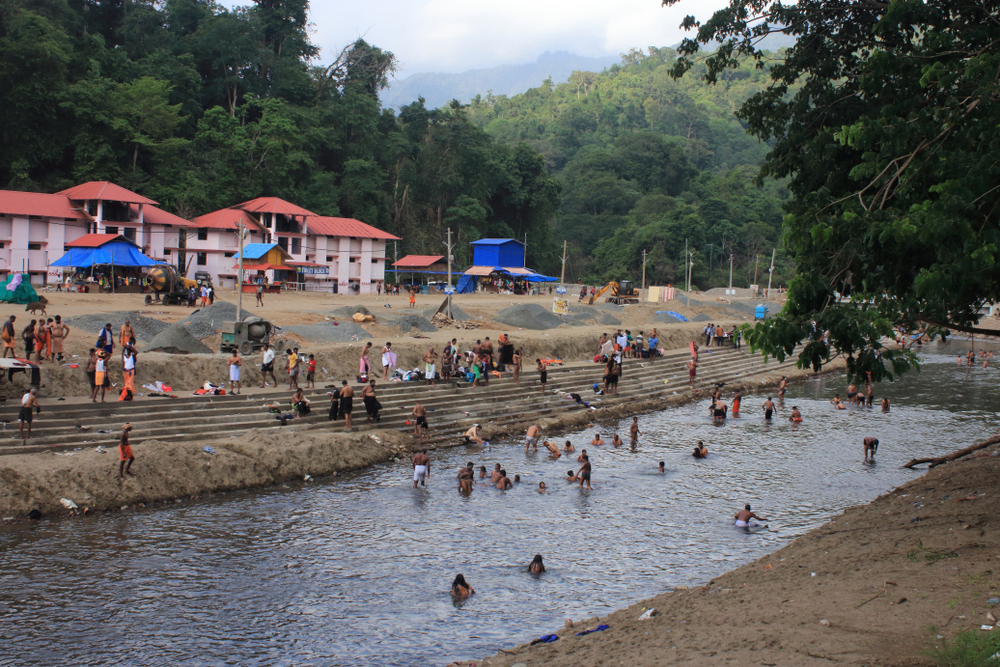Sabarimala Temple
Nestled in the Western Ghat mountain ranges of Kerala, India, Sabarimala Temple is not just a place of worship; it is a testament to centuries of devotion and a cradle of spiritual enlightenment. The journey of faith, the allure of devotion, and the sacred serenity of Sabarimala Temple.
Recommended: Safety Tips to Reach Sabarimala
Sabarimala Temple History
Here’s a glimpse into the history that has shaped this revered temple:
- Ancient Roots: Sabarimala Temple traces its roots back to ancient times, with mentions in various Hindu scriptures. The temple is associated with the legendary story of Lord Ayyappa, the son of Lord Shiva and Lord Vishnu (in the form of Mohini). The tales of his divine birth and purpose are inscribed in the depth of Hindu mythology.
- Pilgrimage Traditions: The unique aspect of Sabarimala is its pilgrimage traditions. Unlike other temples, Sabarimala opens its doors to devotees only during certain specific periods. The temple is open to all, irrespective of caste, creed, or religion, during the Mandalam-Makaravilakku season, which typically begins in November and concludes in January.
- Ayyappa’s Journey: The pilgrimage to Sabarimala is a symbolic journey mirroring Lord Ayyappa’s life. Devotees undertake a challenging trek through dense forests and steep hills, embodying the ascetic life that Lord Ayyappa embraced. The journey symbolizes self-discipline, devotion, and the pursuit of spiritual knowledge.

Sabarimala Temple Location
The geographical location of Sabarimala Temple adds to its mystique, making it a spiritual retreat nestled in the lap of nature:
- Western Ghats: Sabarimala is situated in the Periyar Tiger Reserve, part of the Western Ghats, a UNESCO World Heritage Site. Surrounded by dense forests, the temple stands at an altitude of 914 meters, providing a serene atmosphere for devotees.
- Pathanamthitta District: The temple is located in the Pathanamthitta district of Kerala, known for its lush greenery and picturesque landscapes. The district is often called the “Pilgrim Capital of Kerala,” owing to its religious significance and numerous temples.
- Pampa River: Pilgrims have to cross the sacred Pampa River before commencing the trek to Sabarimala. The river is considered auspicious, and a ritual bath here is integral to the pilgrimage.
Sabarimala Temple Darshan Timings
Understanding the darshan timings of Sabarimala is crucial for pilgrims planning their visit. The temple operates on a unique schedule, with specific periods designated for darshan:
- Mandalam-Makaravilakku Season: This is the main pilgrimage season and typically spans from mid-November to mid-January. During this time, the temple is open for darshan, attracting millions of devotees. The highlight is the Makaravilakku festival, celebrated on Makar Sankranti, where a divine light, known as Makara Jyothi, is believed to appear on the hills.
- Monthly Poojas: The temple is open for monthly rituals and poojas during the Malayalam months of Karkidakam, Thulam, and Medam. These poojas attract a smaller number of devotees compared to the Mandalam-Makaravilakku season.
- Special Occasions: Sabarimala also opens its doors for special occasions such as Vishu, Onam, and other festivals, though the crowd during these times is relatively lesser compared to the main pilgrimage season.
Sabarimala Temple Opening Date
The opening date of Sabarimala Temple sets the tone for the pilgrimage season. Devotees eagerly await the moment when the temple doors open, marking the commencement of the sacred journey:
- Mandalam Puja: The temple opens for the Mandalam-Makaravilakku season with the Mandalam Puja. The opening date is usually in November. The exact date varies each year based on the Malayalam calendar.
- Neyyabhishekam: On the opening day, the ritual of Neyyabhishekam takes place. Devotees offer ghee as an offering to Lord Ayyappa, symbolizing self-surrender and devotion.
- Makaravilakku: The season culminates with the Makaravilakku festival, celebrated on Makar Sankranti. Pilgrims believe that witnessing the divine light, Makara Jyothi is an auspicious and spiritually elevating experience.
Sabarimala Makara Jyothi History
The history of Makara Jyothi is entwined with the spiritual narrative of Sabarimala and is considered a divine phenomenon by millions of devotees:
- Spiritual Significance: Makara Jyothi, also known as the “divine flame,” is a celestial light that appears on the hills of Sabarimala on the evening of Makar Sankranti. Pilgrims believe it is a manifestation of Lord Ayyappa and a blessing for those who witness it.
- Natural Phenomenon: While some consider Makara Jyothi a divine miracle, others argue that it is a natural occurrence caused by the lighting of a fire by the temple priests. Despite the debates, the spiritual fervor and the sense of divine presence during this moment are undeniable.
- Pilgrim’s Faith: The sight of Makara Jyothi is a culmination of the pilgrim’s arduous journey and a testament to their unwavering faith. It is an experience that pilgrims carry in their hearts, reinforcing their connection with the divine.
How to Reach Sabarimala Temple
Reaching Sabarimala involves a journey through picturesque landscapes and challenging terrains. Here’s a guide on how to embark on this spiritual pilgrimage:
- By Air: The nearest airport to Sabarimala is the Trivandrum International Airport, approximately 170 kilometers away. From the airport, one can hire a taxi or take a bus to reach the Pampa base camp, the starting point of the trek to Sabarimala.
- By Rail: The nearest railway station is Chengannur, approximately 93 kilometers from Sabarimala. Other nearby railway stations include Kottayam and Thiruvalla. From the railway station, buses or taxis can be hired to reach Pampa.
- By Road: Sabarimala is well-connected by road, and KSRTC buses operate from major cities in Kerala to Pampa, the base camp for the pilgrimage. Private taxis and vehicles are also available for hire.
- Trek to Sabarimala: The final leg of the journey involves a challenging trek from Pampa to Sabarimala which is 8km. The trek passes through dense forests and steep hills, symbolizing the spiritual journey of self-discipline and devotion.
Sabarimala Temple is not merely a physical destination; it is a spiritual odyssey, a journey through time, tradition, and transcendence. As pilgrims embark on the trek to this sacred abode, they carry with them the stories of Lord Ayyappa, the divine light of Makara Jyothi, and the echoes of centuries-old traditions. Sabarimala remains a beacon of faith, drawing devotees from all walks of life to experience the divine presence in the heart of the Western Ghats.






